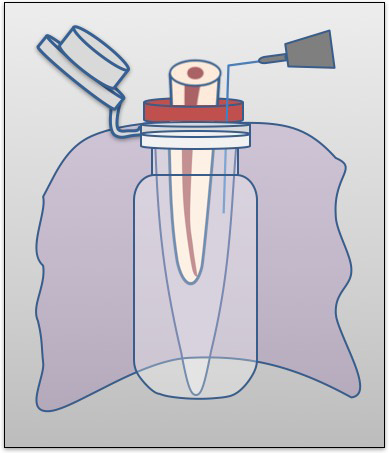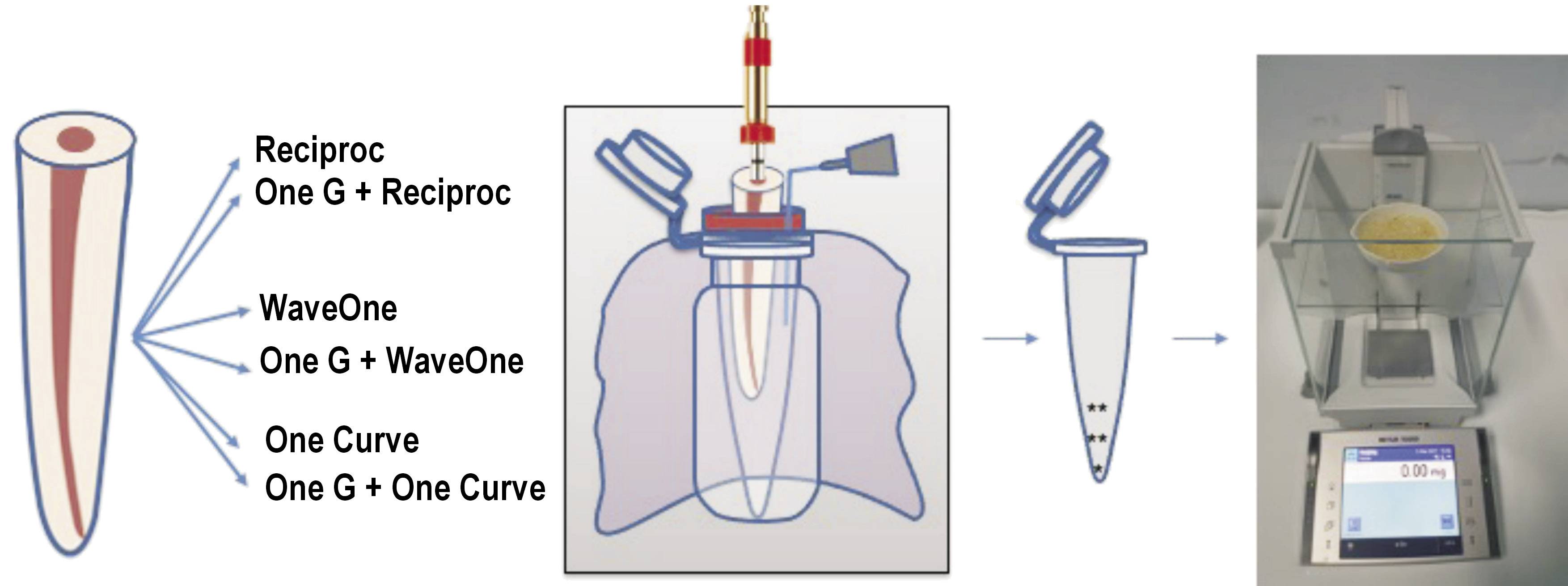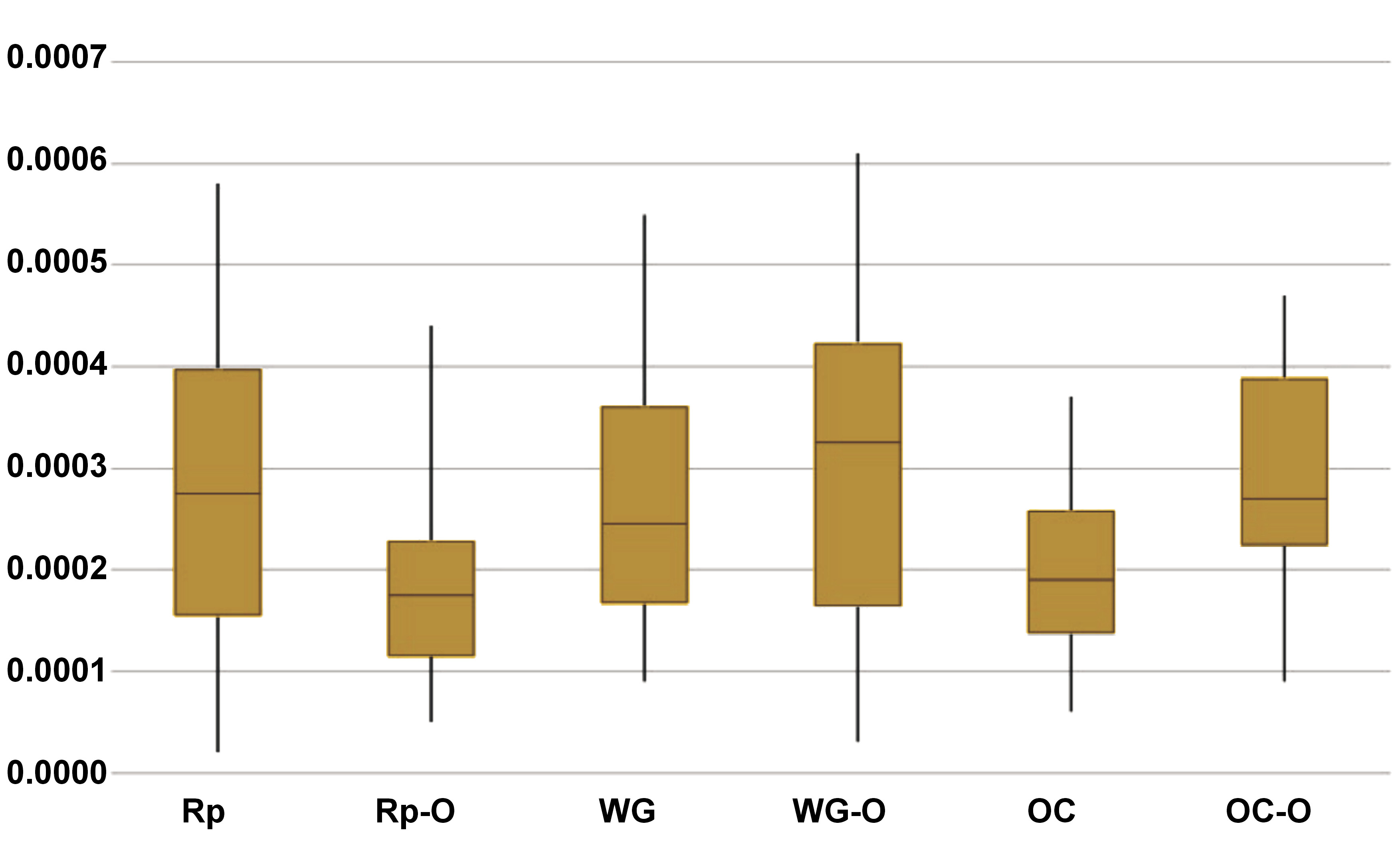Abstract
Background. The dentinal debris produced during root canal preparation can be extruded through the apical foramen, which may cause undesired consequences, such as the postoperative inflammation of periapical tissues.
Objectives. The aim of the present in vitro study was to evaluate the effect of glide path preparation on apical debris extrusion for the Reciproc®, WaveOne Gold® and One Curve file systems.
Material and methods. A total of 72 mandibular incisors were divided into 6 groups according to the nickel-titanium (NiTi) system used and glide path preparation: group Rp – Reciproc; group Rp-O – Reciproc after glide path preparation; group WG – WaveOne Gold; group WG-O – WaveOne Gold after glide path preparation; group OC – One Curve; and group OC-O – One Curve after glide path preparation. The pre- and post-instrumentation weight of Eppendorf tubes was measured. The pre-weight was subtracted from the post-weight to calculate the amount of apically extruded debris. The data was analyzed using the one-way analysis of variance (ANOVA) with the statistical program PASW Statistics for Windows, v.18.0.
Results. No statistically significant differences were found between the single-NiTi file systems with different kinematics in terms of apical debris extrusion, with or without glide path preparation (p > 0.05).
Conclusions. The amount of apically extruded debris was not affected by the kinematics of different single-NiTi file systems. Moreover, creating a glide path had no effect on the apically extruded debris in straight root canals.
Keywords: root canal preparation, dental instruments, root canal therapy, endodontics
Introduction
Postoperative symptomatic apical periodontitis may occur as an undesirable consequence of root canal treatment, and the patient can feel mild to severe pain while chewing.1 It has been previously mentioned that the prevalence of pain 24–48 h after root canal treatment is 40–65%.2 Postoperative pain depends on many factors, such as the existence of preoperative pain, occlusal trauma, and injuries due to the chemical, mechanical and bacterial irritation of periapical tissues during root canal treatment.3, 4 During root canal preparation, the debris containing dentin chips, bacteria and necrotic tissue remnants can be extruded through the periapical area, which is assumed to be one of the major causes of post-treatment periapical inflammation.5 Many factors, such as the instrument design, the number of instruments, the kinematics of the instrument system, the size of apical preparation, and the determination of the working length, can affect the amount of apically extruded debris.6, 7, 8, 9
Reciprocating single-file nickel-titanium (NiTi) systems were introduced as an alternative to continuous rotational multiple-file NiTi systems. It has been claimed that this technique is associated with a safer root canal preparation procedure, decreased cost, reduced preparation time, and the prevention of cross-contamination risk.10 According to a systematic review of studies on reciprocating and continuous rotation, the reciprocating motion is advantageous with regard to fracture resistance, but its effects in terms of shaping ability, dentinal defects and apical debris extrusion are controversial.10
Reciproc® (VDW, Munich, Germany) is the first reciprocating single-file NiTi system. This system is produced with a different NiTi alloy, called M-wire, which is subjected to a different thermal process. This process ensures increased flexibility and mechanical strength of the file.11 The Reciproc file has 2 cutting edges and its cross-section is S-shaped.
The WaveOne® Gold system (Dentsply Maillefer, Ballaigues, Switzerland) has been marketed with the claim that its increased elasticity is due to the heat treatment of the NiTi alloy, which is called Gold-wire. The Gold-wire technology is a procedure of thermocycling, which involves heating and slowly cooling the file. This procedure results in the file changing to a gold color.12 The file has a parallelogram cross-section with 2 cutting edges.
One Curve (Micro-Mega, Besançon, France) is a heat-treated rotary file that enables shaping the root canal with a single instrument. One Curve is manufactured from a C-wire NiTi alloy, which has a controlled memory property. The manufacturer claims that the pre-bending ability of the One Curve file enhances the process of shaping the root canal. The One Curve instrument has variable cross-sections along the blade.13 To the best of our knowledge, there is one study that compares the effect of this rotational NiTi single-file system with the reciprocating movement on apical debris extrusion.14
A glide path is a smooth tunnel that extends from the orifice of the canal to the minor apical foramen.15 Glide path preparation before the enlargement of the main root canal has been recommended to minimize the risk of shaping aberrations, file separation and taper lock.16 A glide path can be formed with either rotary glide path files or hand files. Glide path preparation with manual K-files may be disadvantageous, as the procedure is more time-consuming and more difficult than creating a glide path with rotary NiTi file systems.17 It has also been reported that using manual K-files to form a glide path can result in more postoperative pain.18
One G (Micro-Mega) is a single-file rotary glide path system. The tip diameter of the file is 0.14 mm and the taper is 0.03 throughout the shaft. One G has an asymmetrical cross-section with 3 cutting edges. The manufacturer claims that the design of the file provides a decreased screwing effect. Also, 3 different cutting edges with 3 different radii result in better debris elimination in the coronal direction.19 A recent study showed that One G caused less debris extrusion than manual K-files.20
The aim of the present in vitro study was to evaluate the effect of single-file NiTi systems with different kinematics, alloys and designs on the apically extruded debris with or without rotary glide path preparation. The null hypothesis was that there would be no difference between the Reciproc, WaveOne Gold and One Curve files in terms of the amount of apically extruded debris, with or without glide path preparation.
Material and methods
The procedure of the study was approved by the Ethics Committee at Eskişehir Osmangazi University, Turkey, with the reference number 25403353-050.99-E.110594. A total of 72 freshly extracted mandibular incisor teeth, removed for periodontal and prosthetic reasons, were selected for this study. The inclusion criteria for the specimens were that the teeth should have mature apices, no previous endodontic treatment, Vertucci I root canal configuration, and no visible cracks on the root surface. The extracted teeth were cleaned with a scaler to remove tissue remnants, and placed in 5% sodium hypochlorite (NaOCl) for 10 min for disinfection. The teeth were then washed with tap water and stored in distilled water until use. The length of all teeth was standardized to 18 mm by decoronation, and endodontic access cavities were prepared using diamond burs under water cooling. Eppendorf tubes were pre-weighed on an electronic scale with a precision of 10−5 g (Mettler-Toledo, Greifensee, Switzerland). Three consecutive measurements were obtained to calculate the average weight of the tubes.
Debris collection
An experimental model was prepared for the evaluation of apical debris, as described by Myers and Montgomery.21 The pre-weighed Eppendorf tubes were used for debris collection. Holes were created in the rubber stoppers of the vials, and the specimen was inserted through the rubber stopper and fixed with Teflon tape to prevent the leakage of the irrigation solution through the space between the rubber stopper and the specimen. A 27-gauge needle was inserted into the Eppendorf tube through the rubber stopper to equalize air pressure. The entire experimental setup was obscured with a rubber dam sheet to prevent the operator from seeing the apex (Figure 1).
Root canal instrumentation
The specimens were randomly divided into 6 groups (n = 12) according to root canal preparation. A #10 K-file (VDW) was inserted into the root canal until it was visible at the apical foramen, and the working length was established by subtracting 1 mm from this length. Teeth with apical patency of no more than ISO #10 were included in this study. The groups were as follows:
– group Rp – root canals were prepared with a Reciproc file (VDW), with a #25 tip diameter and 0.08 taper;
– group Rp-O – glide path preparation was done with a One G file (Micro-Mega), and then root canals were prepared with the Reciproc file;
– group WG – root canals were prepared with a WaveOne Gold primary file (Dentsply Maillefer), with a #25 tip diameter and 0.07 taper;
– group WG-O – glide path preparation was done with a One G file, and then root canals were prepared with the WaveOne Gold primary file;
– group OC – root canals were prepared with a One Curve file (Micro-Mega), with a #25 tip diameter and 0.06 taper; and
– group OC-O – glide path preparation was done with a One G file, and then root canals were prepared with the One Curve file.
The One Curve file was used with an in-and-out motion without pressure at a rotational speed of 300 rpm and a torque of 2.5 N·m, using a torque-controlled endodontic motor (X-Smart Plus; Dentsply Maillefer). A slow, in-and-out pecking motion was used for the Reciproc and WaveOne Gold files, according to the manufacturers’ instructions. After several in-and-out movements, the files were removed and cleaned. The canal was irrigated with distilled water, and apical patency was confirmed using a #10 K-file. This procedure was repeated until the NiTi instrument reached the working length.
Distilled water in the amount of 8 mL was used as an irrigation solution with a syringe and a 29-gauge side-vented NaviTip™ irrigation needle (Ultradent Products, Inc., South Jordan, USA). Apical patency was assessed with a #10 K-file before final irrigation. Final irrigation was performed with 2 mL of distilled water. The root apex was washed with 0.5 mL of distilled water to collect the debris adhering to the external surface. During root canal preparation, the apically extruded debris was collected in the pre-weighed Eppendorf tubes. The tubes were stored in an incubator at 68°C for 5 days to allow the evaporation of distilled water. Three consecutive weight measurements were obtained, and the mean post-instrumentation weight was calculated for each tube. The amount of extruded debris was calculated by subtracting the pre-instrumentation weight from the post-instrumentation weight of the Eppendorf tubes (Figure 2). A single operator performed all experimental procedures.
Statistical analysis
The study had a randomized plot design with the root canal preparation technique as an independent factor and 12 replicates. The one-way analysis of variance (ANOVA) was conducted to analyze apical debris extrusion. All statistical analyses were performed using the PASW Statistics for Windows, v. 18.0 (SPSS Inc., Chicago, USA), with a significance level of 5%.
The mathematical model of variance analysis (Equation 1):
where:
Yij – the jth observation on the ith level of treatment;
µ – the common effect for the whole experiment;
αi – the ith treatment fixed effect; and
εij – random error terms.
Results
The minimum, maximum, mean, and standard deviation values with regard to the apically extruded debris for each experimental group are shown in Table 1. The box plots are presented in Figure 3. No statistically significant differences were found among the experimental groups (p > 0.05). All procedures were associated with the extrusion of debris through the apical foramen.
Discussion
The aim of this in vitro study was to evaluate the amount of apically extruded debris during the preparation of root canals, using 3 different single-file systems with or without glide path preparation. According to the results of this study, no statistically significant differences were found among the experimental groups. The null hypothesis was accepted. It was impossible to prevent apical debris extrusion in any of the experimental groups.
The experimental setup described by Myers and Montgomery21 was used for the collection of the apically extruded debris (Figure 1). Since it is not possible to measure the amount of apically extruded debris under clinical conditions, in vitro studies are still conducted to quantify this parameter. It must be kept in mind that in this experimental setup, the absence of apical back pressure may negatively affect the amount of apically extruded debris.22 Previously, floral foam has been used to simulate apical negative pressure and overcome the limitations of this setup.23 However, floral foam may absorb the irrigation solution and debris, thus influencing the test results.21, 22 The apical preparation size is another factor that can affect the amount of apically extruded debris.9 The size of the main file should be the same in all experimental groups for standardization. In this study, all single-file systems had the same apical size (#25) to ensure standardization. The volume and type of the irrigation solutions used in the preparation procedure might also affect the amount of apically extruded debris.7 NaOCl crystals can remain in the collected debris after the evaporation procedure, which may affect the test results. In this study, distilled water was used for all irrigation procedures to evaluate solely the effect of the file type and glide path preparation. Also, the volume of the irrigation solution was kept the same for all experimental groups. It has been previously found that the determination of the working length as −1 mm from the apical foramen significantly decreases the amount of apically extruded debris.21 Therefore, in this study, the working length was determined as −1 mm from the apical foramen.
Previous in vitro studies have examined whether there is a difference in the amount of apically extruded debris in the teeth prepared with either multiple-file or single-file systems.22, 24, 25, 26 Whereas some studies report that multiple-file systems cause more apically extruded debris, blaming the increased number of files,24, 26 others report that it is the single-file systems that cause more debris extrusion.25, 27 Also, in a recent systematic review, it was concluded that the design of the file is the most dominant factor affecting the apically extruded debris.7 Studies comparing the effect of single-file reciprocating and full-sequence rotational systems have also reported different results.22, 28, 29 Various types of cross-sections and the taper of the files, specimens with straight or curved canals, the design of irrigation needles, and the preparation protocols used in each study might be responsible for the different study results. According to a recent report on apical debris extrusion, the WaveOne Gold single-file reciprocating system causes a similar amount of debris extrusion as the Reciproc system and less debris extrusion than the HyFlex™ EDM single-file rotational system.29 This partially contrasts with our findings. Our results showed that there was no significant difference between the 2 single-file reciprocating systems and the single-file rotational system. This difference may result from the different designs of full-sequence rotational system files, such as taper and cross-section, and different study designs. To our knowledge, only one study has examined apical debris extrusion for the One Curve system; the previous study reported that the amount of apically extruded debris was greater for WaveOne Gold as compared to One Curve.14 This difference with regard to the findings of the present study may result from the different study designs and operative effects.
Glide path preparation before the enlargement of the root canal has been recommended to reduce procedural errors.16 Manual files and multiple-file rotary NiTi glide path systems have been used for glide path preparation. Single-file NiTi glide path systems were designed to reduce the number of files and the time spent on creating a glide path. According to our study, creating a glide path with the One G glide path file did not affect apical debris extrusion in any experimental group. Topçuoğlu et al. stated that creating a glide path before preparing root canals with reciprocating and rotational single files reduced the amount of apically extruded debris.30 This result is not consistent with our results. A possible reason for this may be the different study design. In the present study, mandibular incisors were used, whereas Topçuoğlu et al. used mandibular molars with curved canals.30
Taking into account the construction of the experimental setup in the present study, it was more likely to mimic the natural position of mandibular teeth. Gravitational force will have different effects on the amount of irrigant and debris extrusion in mandibular and maxillary teeth. Also, the absence of apical back pressure might affect the amount of irrigant and debris extrusion. Therefore, clinicians should interpret the results of this study with caution. Within the limitations of this study, it can be concluded that creating a glide path before root canal preparation with single-file reciprocating or rotational NiTi systems did not change the amount of apically extruded debris in straight root canals. However, the possible advantages of creating a glide path are not limited to reducing apical debris extrusion. Other advantages, such as decreasing the risk of shaping aberrations, file separation and taper lock, should also be considered.
Conclusions
The amount of apically extruded debris was not influenced by either reciprocating or full-sequence rotational single-file NiTi systems. Furthermore, creating a glide path did not affect the amount of apically extruded debris in straight root canals.
Ethics approval and consent to participate
The procedure of the study was approved by the Ethics Committee at Eskişehir Osmangazi University, Turkey, with the reference number 25403353-050.99-E.110594.
Data availability
The datasets supporting the findings of the current study are available from the corresponding author on reasonable request.
Consent for publication
Not applicable.


















